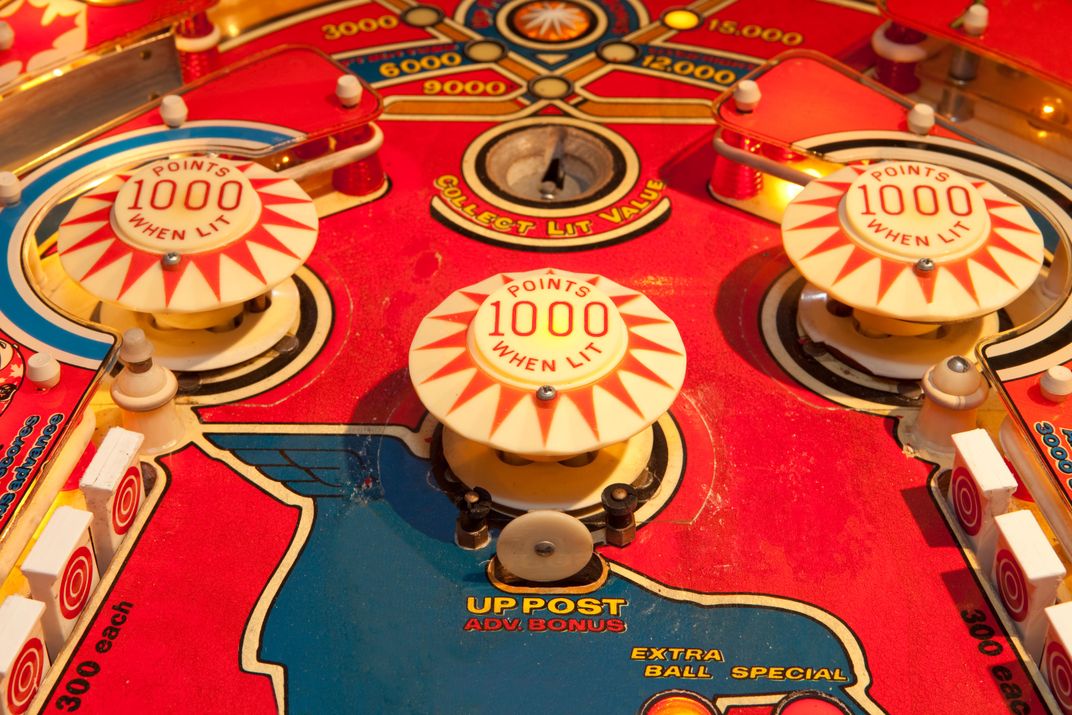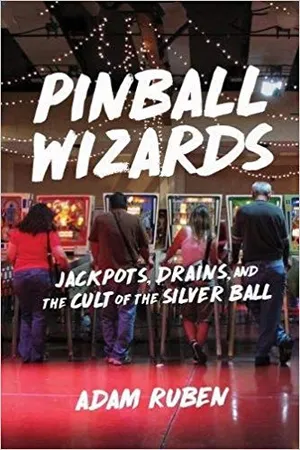What the Popularity of ‘Fortnite’ Has in Common With the 20th Century Pinball Craze
Long before parents freaked over the ubiquitous video game, they flipped out over another newfangled fad
/https://tf-cmsv2-smithsonianmag-media.s3.amazonaws.com/filer/99/8d/998d3825-0872-438d-9fd4-8f805409af09/dec018_b01_prologue.jpg)
This summer, a British firm that processes divorce filings discovered a startling fact. Of the 4,665 petitions for divorce they’d received in 2018, two hundred of them claimed the marriage had been destroyed because one of the partners had become addicted to video games like Fortnite. Or to put it another way, Fortnite and its ilk were responsible for fully 5 percent of all divorces the firm was seeing.
Fortnite, for those who haven’t heard the news, is the wildly popular game du jour. Launched in 2017, by this summer it had already amassed 125 million users, all of whom love its most popular mode: You play as one of 100 combatants dropped on a bucolic island, where you scavenge for weapons and try to kill the others before they kill you. The last one standing wins. It sounds grim, but the game’s aesthetic is very cartoony—there’s no blood or gore—so it’s arguably closer to paintball than, say, The Hunger Games.
Both fans and critics agree on one thing: It’s remarkably compulsive. “I work with a lot of kids who sneak down at 3 in the morning to play,” says Jennifer Powell-Lunder, a clinical psychologist. Twitter is afire with parents complaining about their glaze-eyed children: “Addicted to it like a drug. Had to take the Xbox away for a few days,” one mother posted. Schools have banned it after finding kids playing under their desks on their phones.
The addictiveness of video games is now squarely in the public spotlight. For years, critics worried the games would breed a generation of hyperviolent kids, a fear that never panned out. But now the panic has shifted to how the games are designed to get kids hooked—particularly given that game-laden smartphones are with kids all day long. In mid-2018, the World Health Organization began officially recognizing “gaming disorder,” characterized by “impaired control over gaming.”
As with violence, these fears are probably overblown, as psychologists like Powell-Lunder note. The great majority of kids learn to self-regulate, and appreciate when parents help set limits, she says. Plus, Fortnite has many benefits, she notes: “It’s enormously social—it’s a really good connector,” attracting many girls and other kids who normally don’t play games.
So Fortnite won’t turn kids into zombies. But it’s interesting that so many fear it will. There’s something about newfangled games, it seems, that deeply unsettles us—as we can spy by looking back 100 years, when a new form of play rocked the nation, inspired inflamed headlines, and then was actually banned in many cities for decades. That dread game? Pinball.
* * *
Pinball originally emerged from bagatelle, a 19th-century pastime that was like billiards, except players propelled the ball through a series of pegs toward a target. The boozy, decadent courtesans of the French king loved it. “They’d play these games, and they’d go off and have sex,” as Michael Schiess, founder and creative director of the Pacific Pinball Museum, describes the general air of courtly excess. “Then they’d drink more and they’d play this game.”
Not long after, the game arrived in American bars, and local inventors began tweaking it. In 1871, the British immigrant Montague Redgrave patented Improvements in Bagatelles: He increased the tilt of the board, and the player shot the ball upward with a plunger, trying to land it in scoring areas while bouncing through the thicket of pins—hence, “pinball.” Redgrave turned the game into a tango of physics, “combining gravity with muscular power to act as antagonistical forces,” he boasted. Soon, coin-operated versions spread all over the country.
But pinball wasn’t a true phenomenon until the Great Depression. Legions of out-of-work Americans were looking for quick and cheap entertainment, so the manufacturing firm Gottlieb created Baffle Ball, the first pinball game to become a hit. The company began making 400 a day, and eventually sold 50,000, making it one of the best-selling pinball cabinets ever.
Pinball manufacturers quickly began trying to one-up each other by introducing new accouterments that made the game more dynamic. They added round bumpers that would bounce the ball around chaotically, bells and lights and automated score-counters.
As pinball exploded in popularity, though, it began to develop a reputation for encouraging laziness and vice. Some of this was propelled by a puritan disdain for unemployed Depression victims daring to spend a coin on some entertainment. “There was this angst of, are these people ever going to be productive?” says Karen Sternheimer, professor of sociology at the University of Southern California and author of Pop Culture Panics. Playing pinball was a symptom of their boredom from lack of work, but it was read as the cause of it: “An adult spending their hard-earned money watching a ball bounce around instead of buying food for their family,” notes Adam Ruben, author of Pinball Wizards.
And many worried that kids were particularly at risk. “The machines hold a special fascination for children,” as Perry Githens, the publisher of Popular Science, wrote. New York Mayor Fiorello La Guardia fulminated about pinball in countless interviews, blaming it for “robbing the public” and the “pockets of school children in the form of nickels and dimes given to them as lunch money.” The operators of the machines themselves? “Slimy crews of tinhorns, well-dressed and living in luxury on penny thievery.”
Plus, pinball back then was often regarded as a form of gambling. This wasn’t entirely wrong: In those early, cruder games, all you did was pull back the plunger and see where the ball went, making it mostly a game of chance. Many pinball lounges egged on players by handing out prizes—like boxes of cigarettes or silk stockings—for lucky high scores, which made them seem like casinos. Worst of all, the mob liked pinball: It was a cash enterprise, good for laundering money, so gangsters financed pinball-making firms. “It was the Depression,” Schiess notes, “so if you wanted to open a factory and manufacture pinball, the only people who had the money, who would lend you the money, is the mob.”
By the late 1930s, La Guardia had enough. He began commanding the police to seize pinball machines, smash them to pieces and dump them in the Hudson River, eventually destroying fully 11,000. (Though first the officers removed the wooden legs, 2,000 of which were refashioned as billy clubs.) The mayor himself lustily swung a huge sledgehammer and, in press photos, wore a white suit while tipping a machine over to its destruction.
* * *
Soon, pinball existed in a curious state: Many towns and cities banned it outright—Los Angeles and Oakland, California, followed New York’s lead—while others permitted pinball parlors to exist, or allowed bars and bowling alleys to have a few machines.
In 1947, pinball changed dramatically when Gottlieb debuted Humpty Dumpty, a game with a delightful new feature: electro-mechanical flippers. Suddenly pinball was no longer purely about luck—it truly was a fight against gravity, with the player balletically timing the flippers to keep the ball in play. Playing a single game for a long time became a mark of cool sophistication. Teenagers loved it—and, in the postwar period of affluence, “adolescence” became a period of relative freedom and leisure for youth.
Pinball was their meme culture. Designers would make games themed off hot trends—everything from surfing to blockbuster movies to major pop acts (one 1967 machine called “Beat Time” was themed off the Beatles, depicting four mop-topped musicians named the Bootles). But pinball still hadn’t lost its sketchy reputation; indeed, the artists who decorated machines often leaned into it, creating cabinets filled with scantily clad women and sexual innuendo.
The moral rot now wasn’t about gambling—it was about teenage delinquency. “Pinball was being played by rock ’n’ rollers—they were going to trash your house,” jokes Schiess.
Parents’ fears ran wild. “They’re in public spaces meeting with other people, but it’s not really social in a productive way because it’s congregating around degenerate activity,” says Daniel Reynolds, an assistant professor of film and media studies at Emory University. Better Homes and Gardens in 1957 warned parents to “act now to keep your child from being victimized” by the debased pastime.
In sheer economic terms, pinball became a pillar of American entertainment: Between 1955 and 1970, it drew in more money than Hollywood, according to NPR. And over the years, the libel against the game began to erode.
Part of what rehabilitated pinball’s reputation? That 1947 improvement of flippers. Once pinball rewarded skill, even some grumpy politicians had to agree it wasn’t a form of gambling. By 1976 in New York City, some City Council members were advocating to end their now decades-long ban; after all, licensing pinball machines and imposing fees would bring in dough for the cash-strapped city. So the pro-pinball pols decided to prove it was a game of skill.
Enter Roger Sharpe, a journalist who’d written about pinball for GQ and the New York Times. He’d discovered the game while a student at the University of Wisconsin—where forms of pinball were legal—then moved to New York, where the only place he could play, illicitly, was in an adult-book store that contained a few of the banned, samizdat machines.
On April 1, 1976, Sharpe showed up at a courtroom in Lower Manhattan, where one councilor guided him to the Gottlieb machine Bank Shot. TV cameras peered over his shoulder as he played, capturing the ball with a flipper—“cradling” it—before shooting it off to precisely the location he’d described.
“I cradled, and called shots left and right,” Sharpe says. “I said, ‘This target over here, I’m going to aim and hit it.’” Then he did one last, audacious display of talent: He pointed out that he could even control the ball with the plunger. “If I pull this back the right way, it’s going to go down the middle lane,” he told them. “And it went in a beautiful arc, and went right down the center lane, nothing but net.”
Even the council member who was most hostile to pinball was convinced. The council voted unanimously to end the ban; it was a game of skill.
“He single-handedly saved pinball,” Schiess says.

* * *
Pinball didn’t turn anyone into a delinquent—indeed, with the passage of time, the game now feels positively wholesome. Its sheer tactility seems like a bracing respite from kids staring at screens all day.
“There’s a lot of nostalgia for pinball, because it does seem simpler,” the sociologist Sternheimer tells me. “You’re not going to get so swept up the way you would with an online game. It’s physically restricted, because the machines are so big—it’s not something you carry with you all the time like a phone.”
Many psychologists suspect the panic over Fortnite—and the horrors of video game addiction—will dissipate in a similar fashion. It’s certainly true that some kids (and, again, adults) play in a compulsive way that interferes with their lives. But as Andrew Przybylski, director of research of the Oxford Internet Institute, has found, “the circumstances that lead you to play a game in an obsessive way probably have more to do with your situation than the game.”
There are indeed aspects of gaming culture that raise concerns, though—and ironically, they’re similar to the ones that initially doomed pinball: the specter of gambling. Many video games in the last decade have evolved a “free to play” economics, where the game costs nothing upfront, but it later encourages the player to buy “loot boxes” that have a random chance of containing a rare “power-up” or item. Players thus wind up maniacally buying loot boxes—and blowing money in a fashion that’s indistinguishable from spending wildly on lottery scratch tickets.
Yet Fortnite, the game of the day, has comparatively few loot dynamics in its “battle royale” mode: It’s very much just a test of skill, as the psychologist Jennifer Powell-Lunder notes.
Perhaps video games like Fortnite will one day evolve, in the cultural imagination, the way pinball did. Maybe 30 years from now, today’s kids will be looking at their own children—jacked into their neural implant, and gazing blank-eyed at a newfangled game blasted straight into their cerebral cortex—and wish nostalgically that everyone could go back in time, to play something that teaches persistence and teamwork, with the good old physical skills of using a real joystick. Fortnite, they’ll sigh.
/https://tf-cmsv2-smithsonianmag-media.s3.amazonaws.com/accounts/headshot/Clive_Thompson_photo_credit_is_Tom_Igoe.jpg)


/https://tf-cmsv2-smithsonianmag-media.s3.amazonaws.com/accounts/headshot/Clive_Thompson_photo_credit_is_Tom_Igoe.jpg)